The document is the 2014 annual report of the CGIAR Research Program on Roots, Tubers and Bananas (RTB). It provides an executive summary of RTB's progress in 2014, including efforts to mainstream gender, genetic resource conservation, crop improvement research, pest and disease management, seed systems, cropping systems, and postharvest technologies. The report also lists RTB's partners, donors, people, and selected publications from 2014.


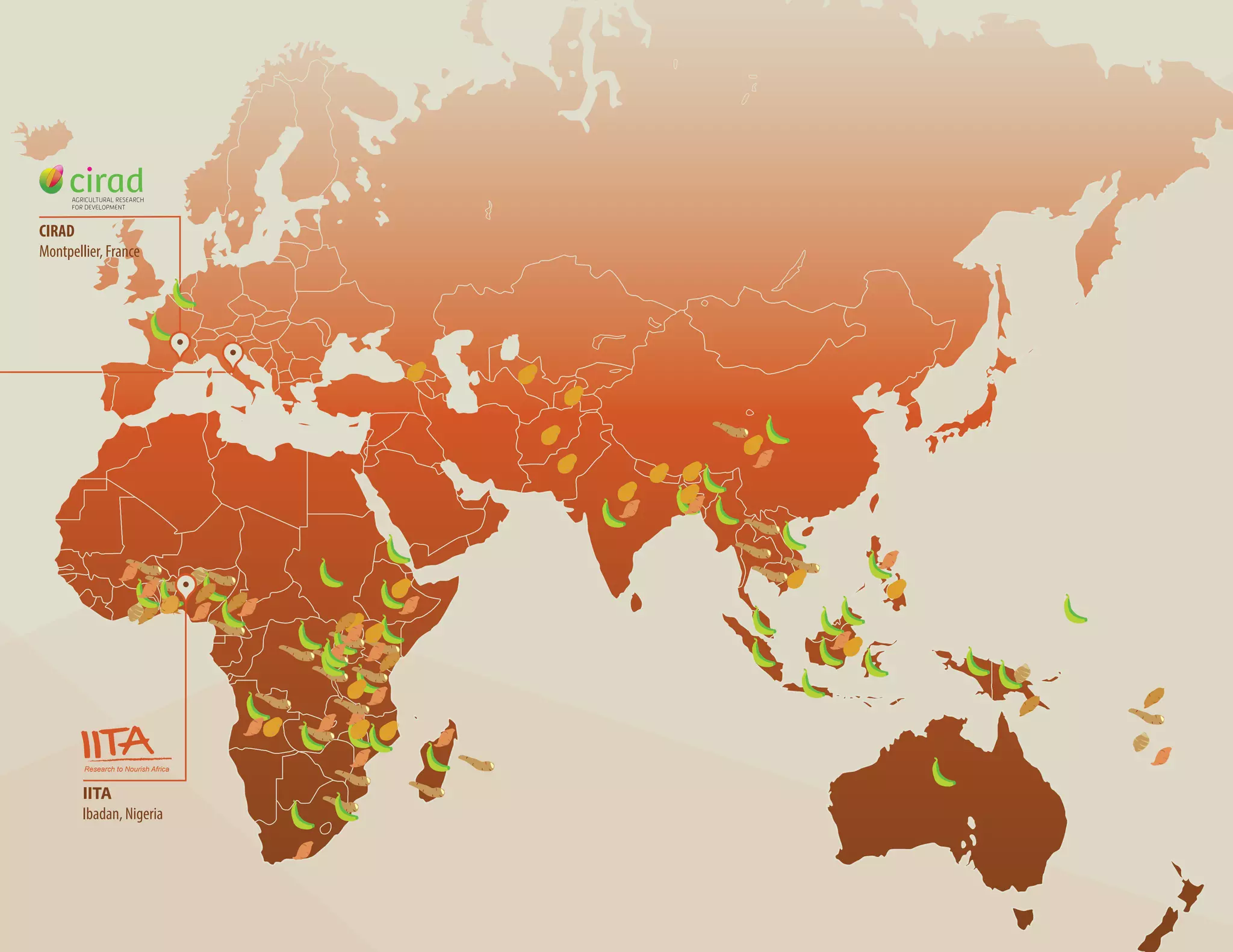
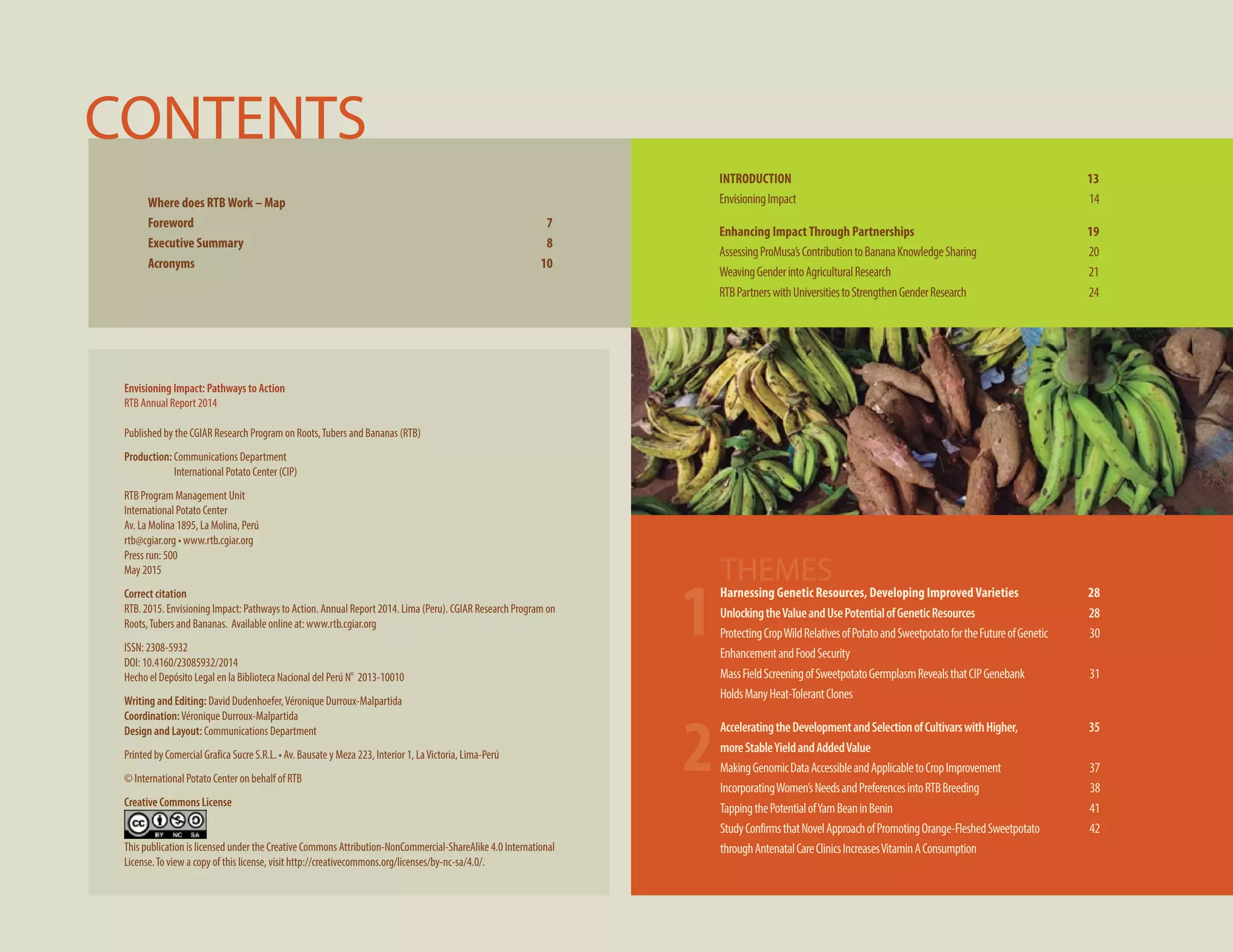





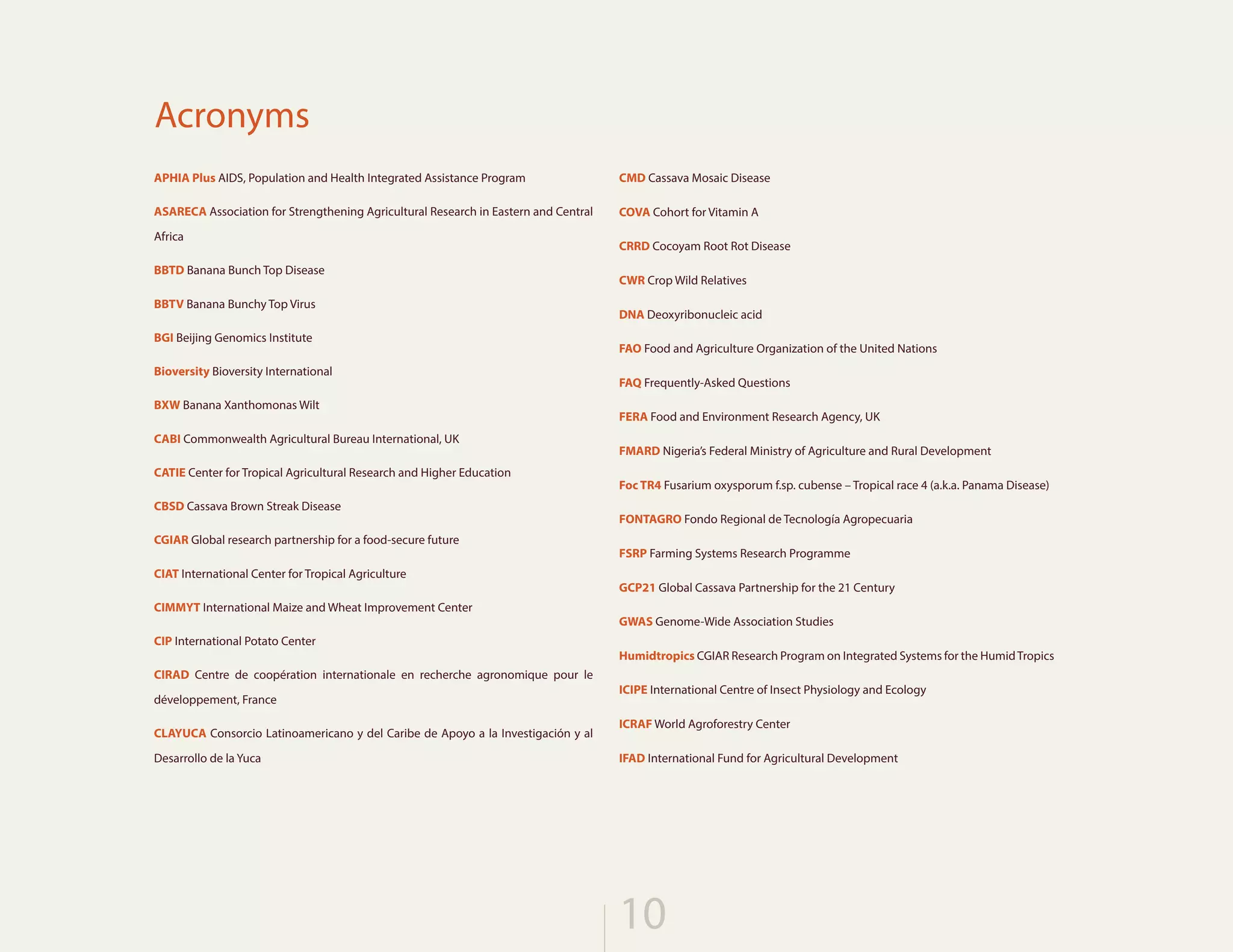



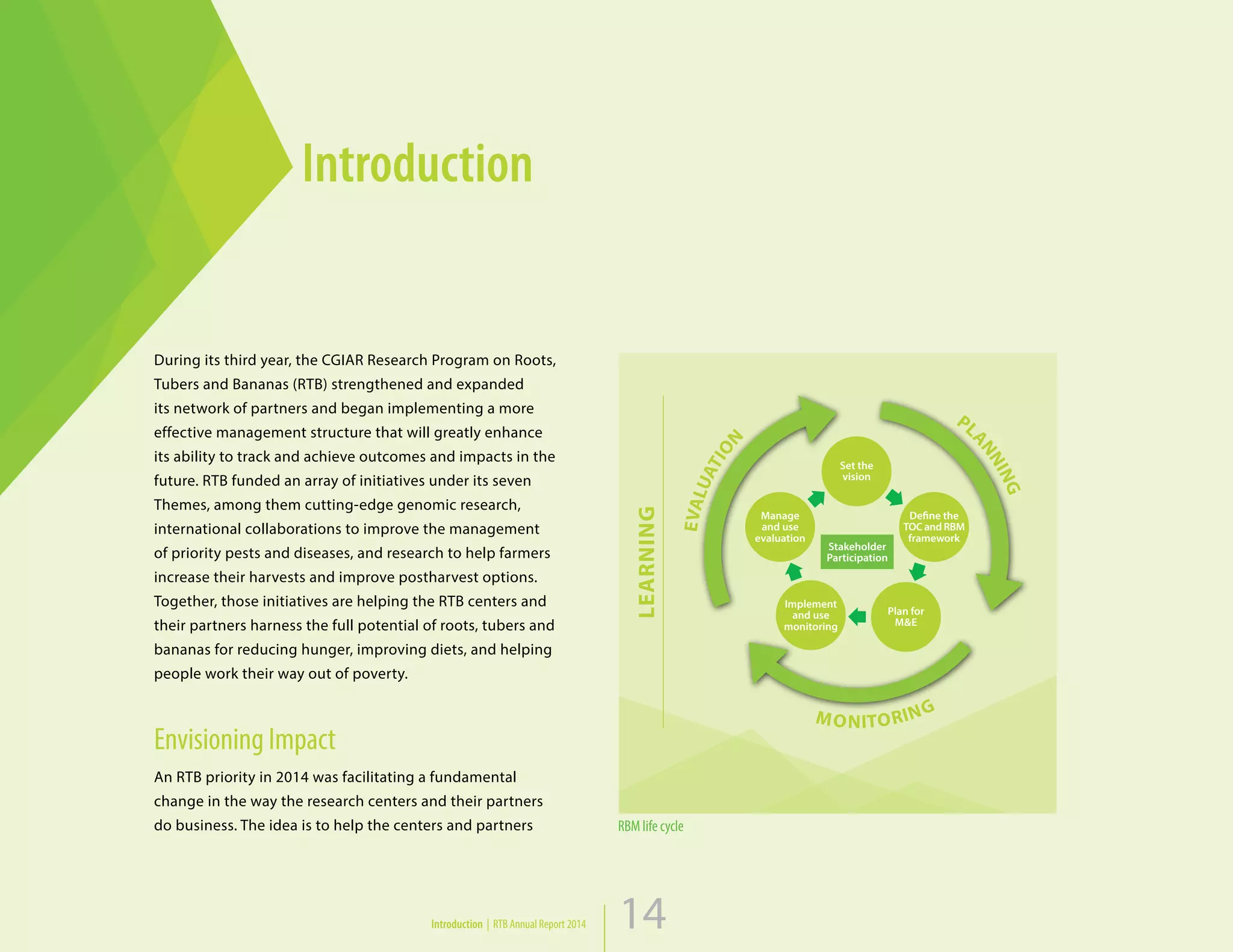

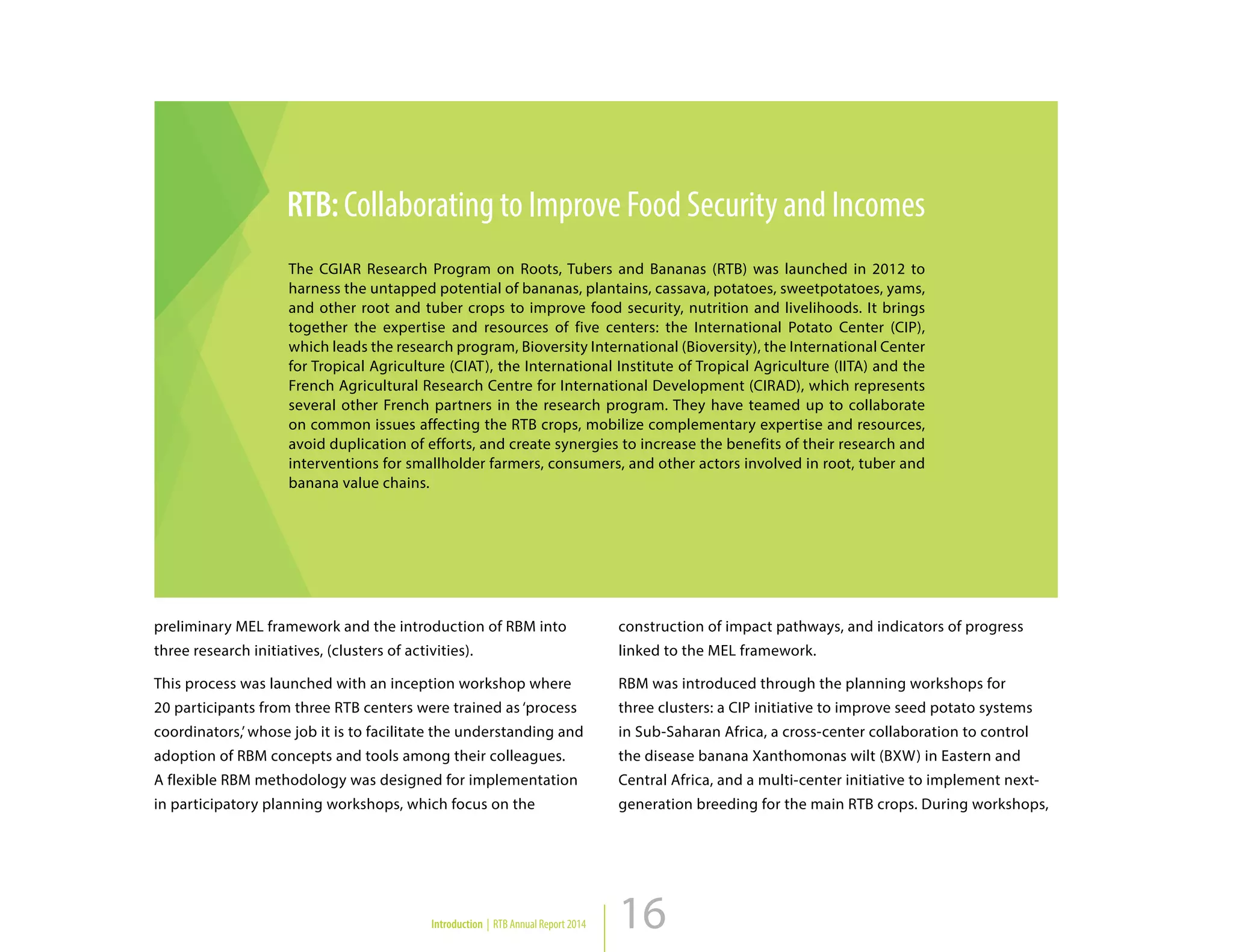






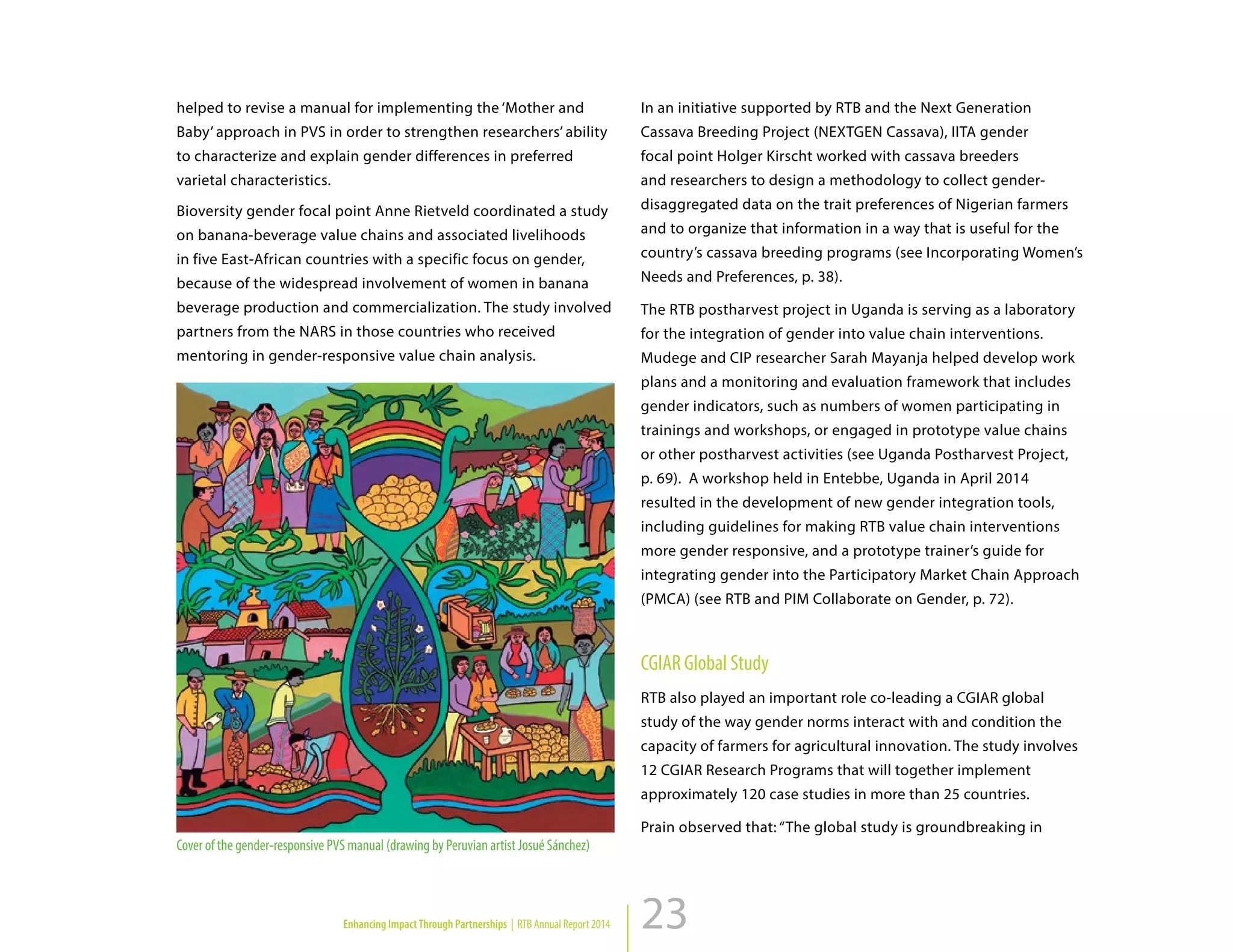



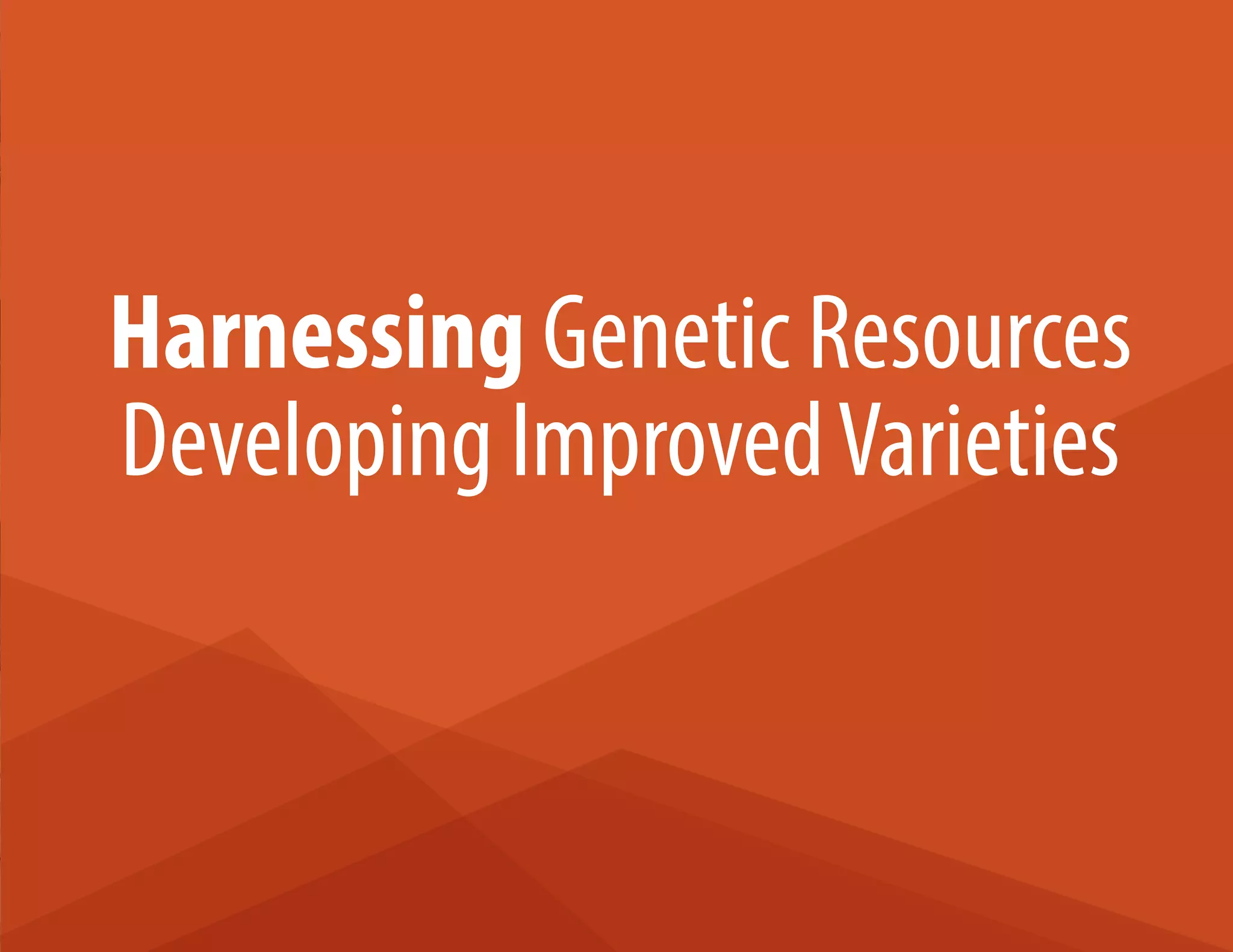
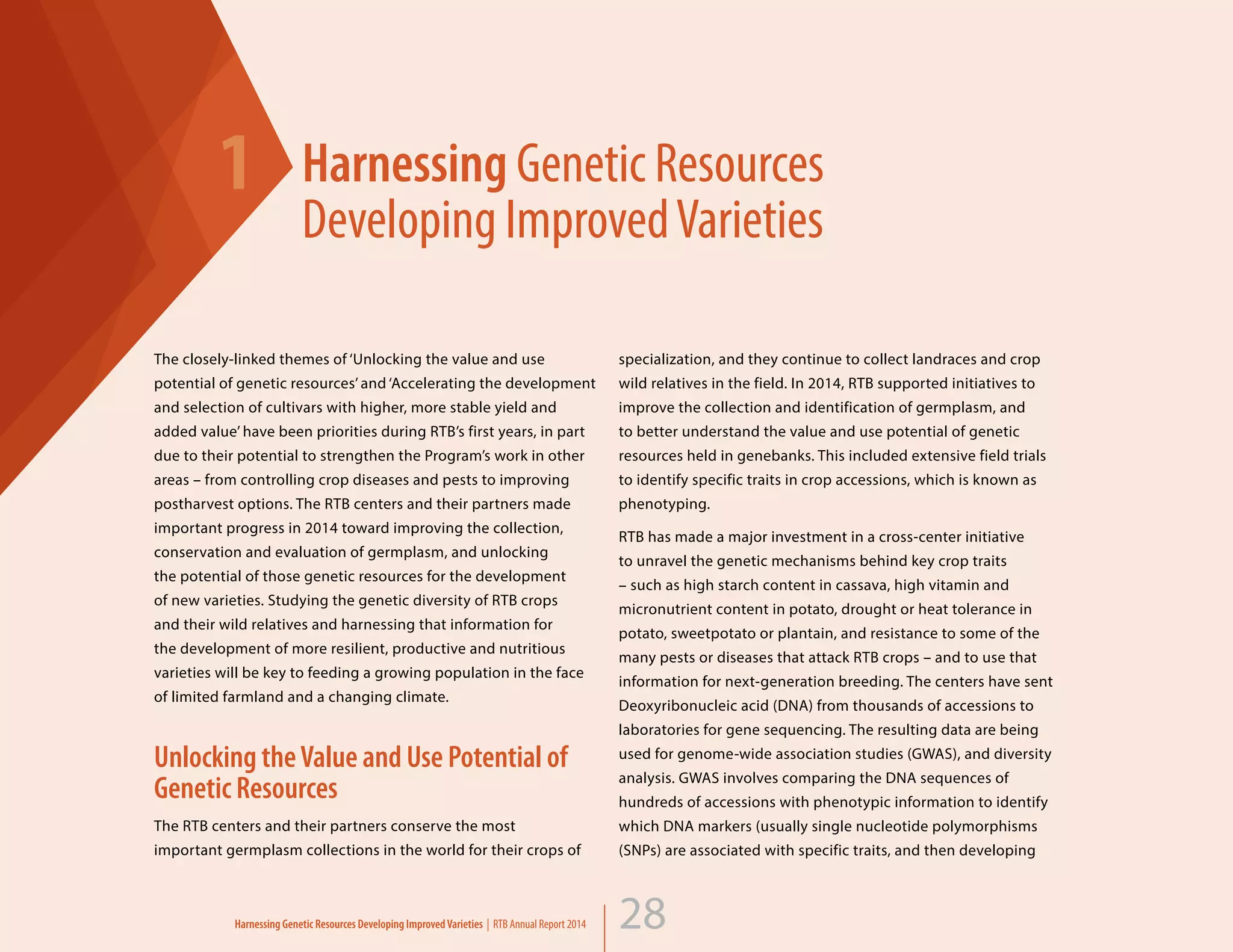

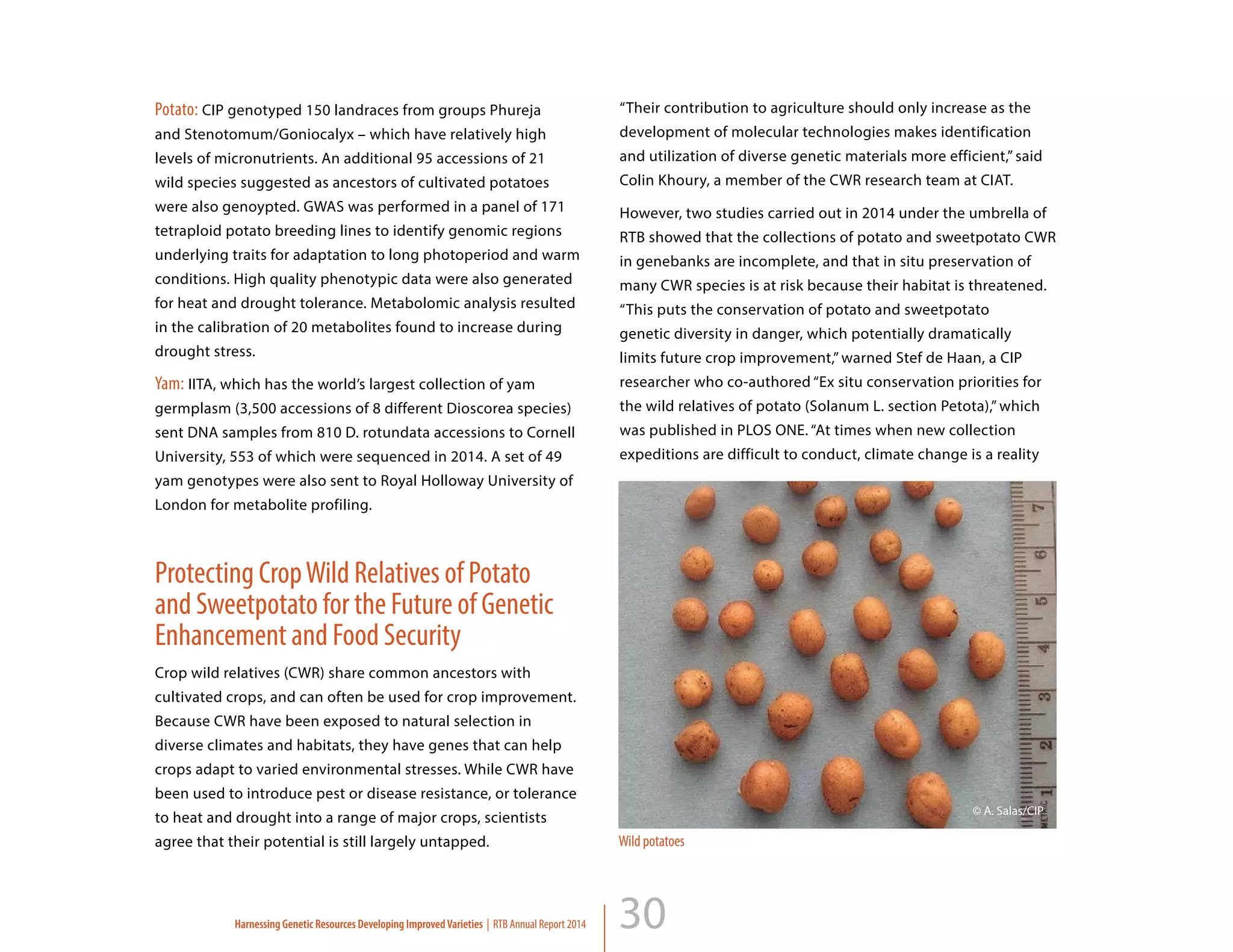
![31
understand the genetic diversity of the crop and tap its potential
for food security.”
For Rick Miller, professor of biological sciences at Southern
Louisiana University, field trials can be combined with genetic
approaches to identify characteristics like drought resistance
in populations of the Batatas complex from around the world
to be used for sweetpotato breeding. “This may sound like an
ambitious goal, but for many crop species, like tomato, corn and
rice, it is a reality,” he said.
Both studies were undertaken as part of the project on “Adapting
agriculture to climate change: collecting, protecting and
preparing crop wild relatives,” managed by the Global Crop
Diversity Trust, Germany and the Millennium Seed Bank of the
Royal Botanic Gardens at Kew in the UK.
Castañeda-Álvarez NP, de Haan S, Juárez H, Khoury CK, Achicanoy HA, Sosa CC, Bernau
V, Salas A, Heider B, Simon R, Maxted N, Spooner DM (2015). Ex situ conservation
priorities for the wild relatives of potato (Solanum L. section Petota). PLOS ONE
Khoury CK, Heider B, Castañeda-Alvarez NP, Achicanoy HA, Sosa CC, Miller RE,
Scotland RW, Wood JR, Rossel G, Eserman LA, Jarret RL, Yencho G, Bernau V, Juarez H,
Sotelo S, de Haan S and Struik PC (2015). Distributions, ex situ conservation priorities,
and genetic resource potential of crop wild relatives of sweetpotato [Ipomoea batatas
(L.) Lam., I. series Batatas]. Front. Plant Sci. 6:251. doi: 10.3389/fpls.2015.00251
Mass Field Screening of Sweetpotato
Germplasm Reveals that CIP Genebank Holds
Many Heat-Tolerant Clones
Scientists in CIP’s Global Program for Genetic Resources
undertook a mass field screening of 1,973 sweetpotato
accessions from the CIP Genebank in the lowlands of northern
Peru that resulted in the identification of 146 accessions that
and habitat destruction abounds, it is essential that in-situ
reserves are established. In-situ conservation is complementary
to genebanks and can support ongoing evolution and adaptive
shifts in population genetics.”
Scientists from CIP and CIAT led genebank gap analyses with
partners around the world to identify gaps in potato and
sweetpotato collections and geographic areas were further
collecting is needed. A total of 32 species of potato wild relatives
(43.8% of those studied) were assigned high priority status
due to significant gaps in genebank collections. In the Andean
highlands specifically – potato’s center of origin – potato crop
wild relatives are threatened as their habitats are impacted by
climate change, land use intensification and the construction of
roads and villages. The researchers recommended immediate
action on both ex situ and in situ conservation.
The gap analysis for crop wild relatives of sweetpotato yielded
even more dramatic results: a total of 78.6% of the species
considered in the study were assessed as high priority for further
collecting and conservation in ex situ collections. The research
findings, published in the journal Frontiers in Plant Science,
also indicate that diversity gaps in ex situ collections largely
align with the geographic distribution of species richness of
sweetpotato CWR, such as “hotspots” in central Mexico and
Central America, and in the extreme southeastern USA. Further
collecting of CWR germplasm should consequently be focused
on these regions.
“Not only do we need more germplasm collecting activities,”
said Bettina Heider, a genetic resources specialist at CIP and co-
lead author of the scientific paper, “we also need more research
on sweetpotato overall, including its wild relatives, to better
Harnessing Genetic Resources Developing ImprovedVarieties | RTB Annual Report 2014](https://image.slidesharecdn.com/5b292f94-4eaa-41b2-ba89-fb7c0436ddde-151017235832-lva1-app6892/75/Annual-Report-RTB-2014-31-2048.jpg)

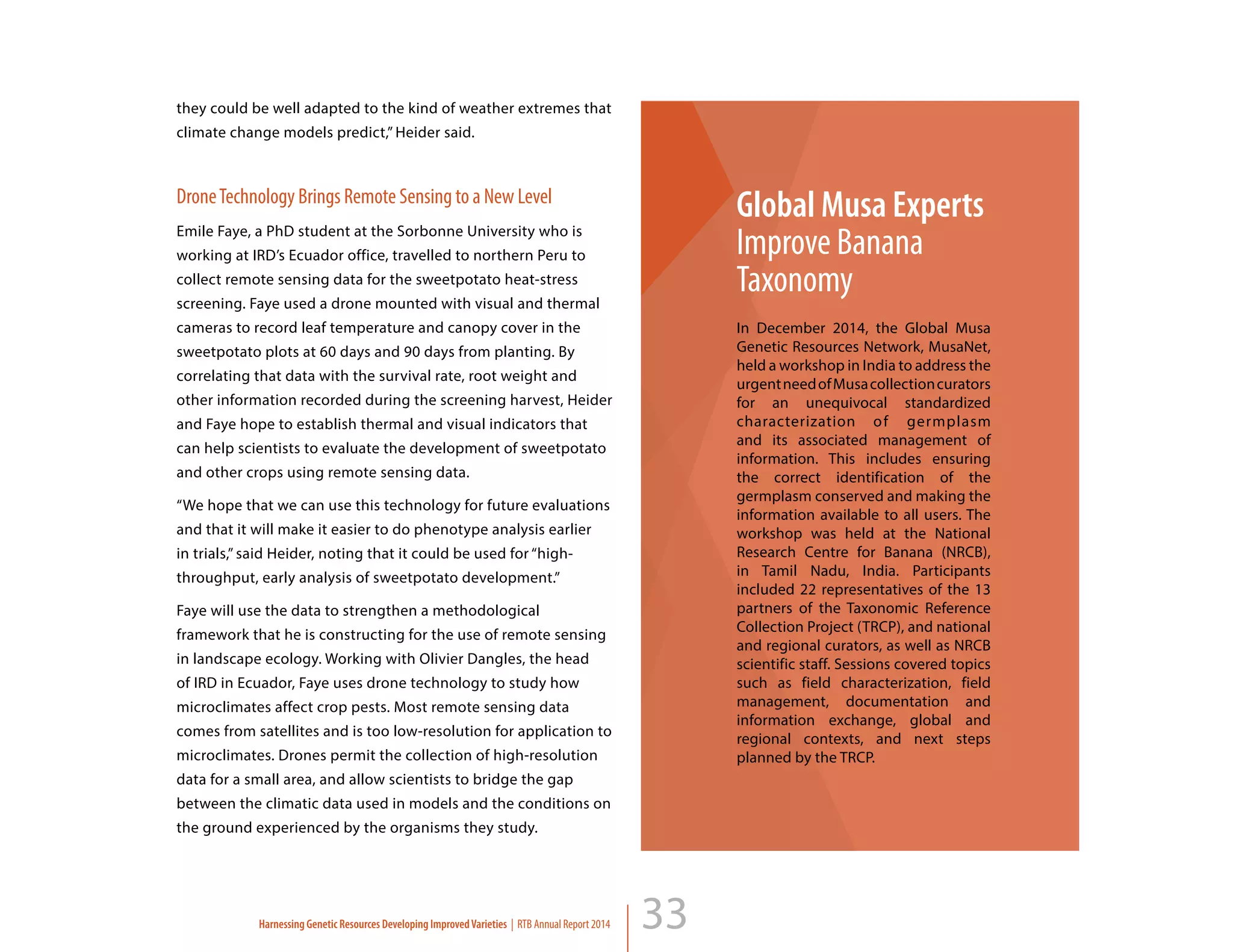
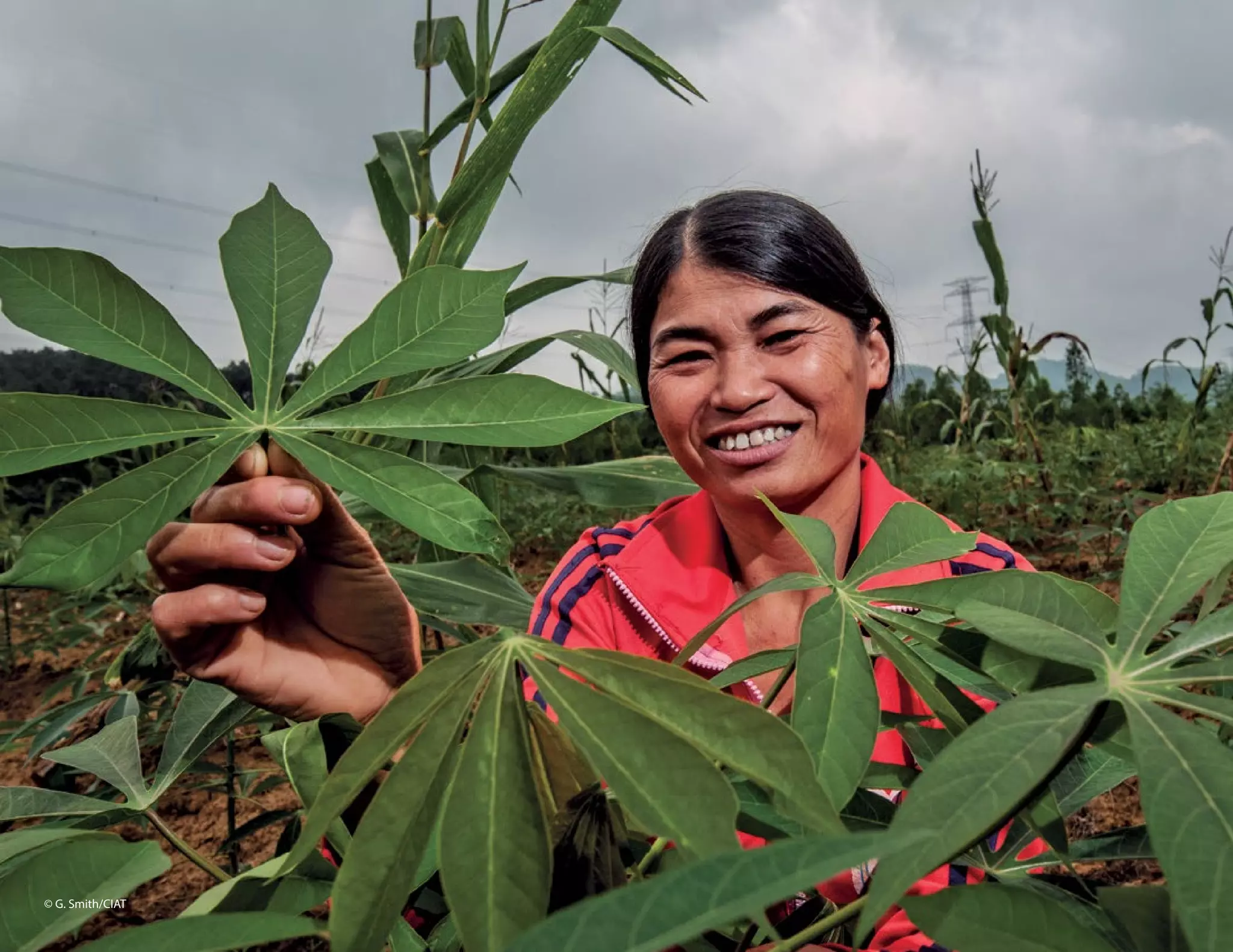
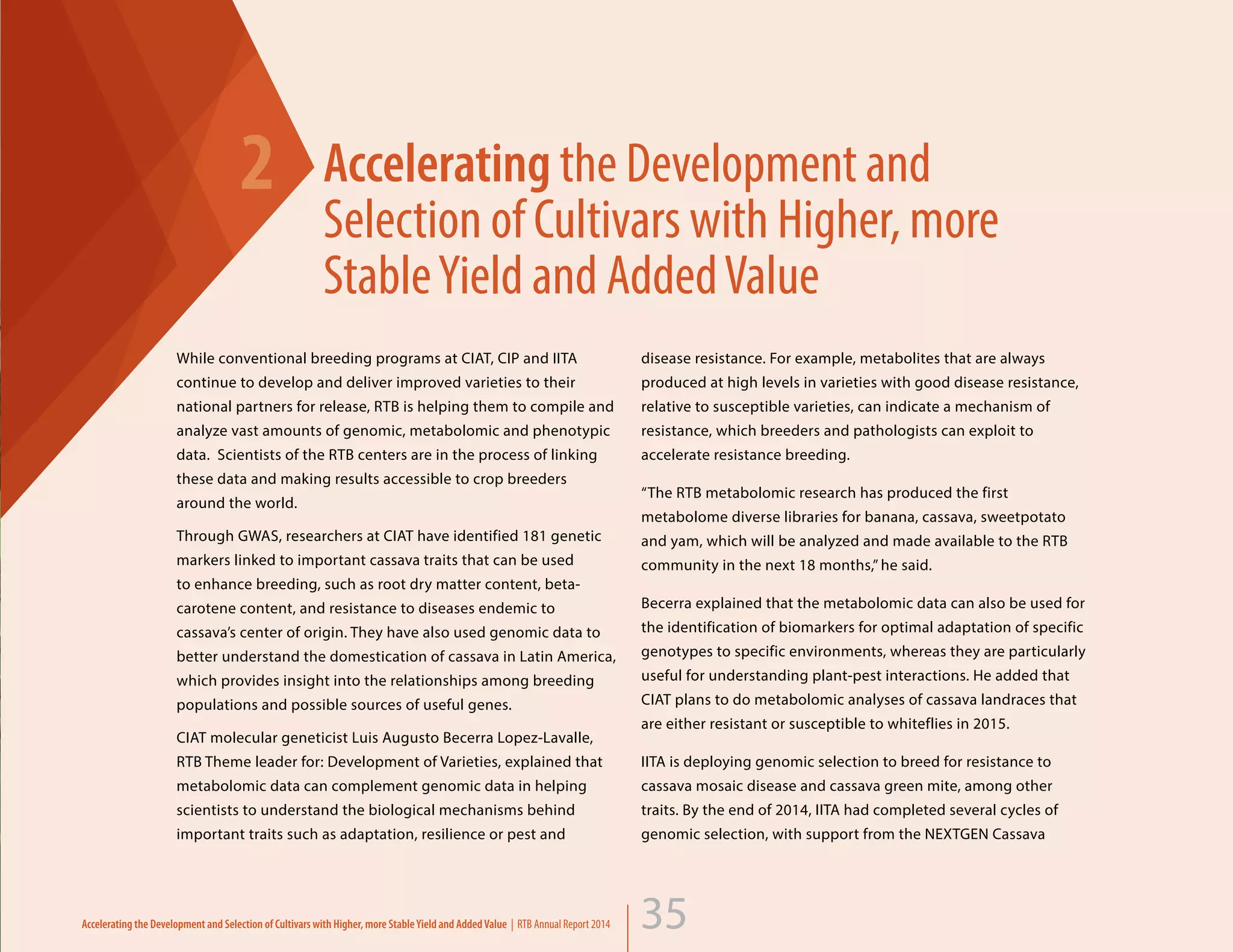


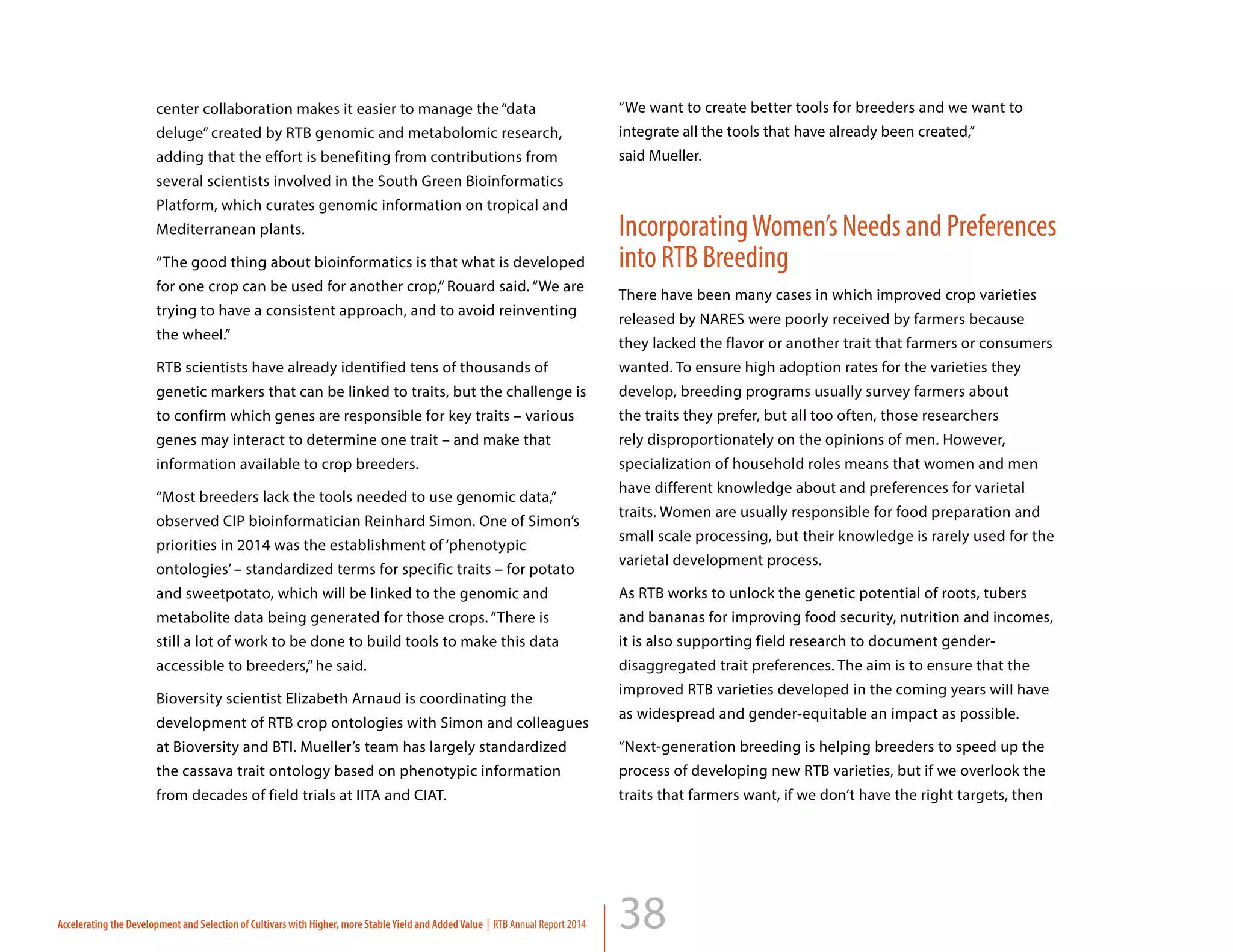



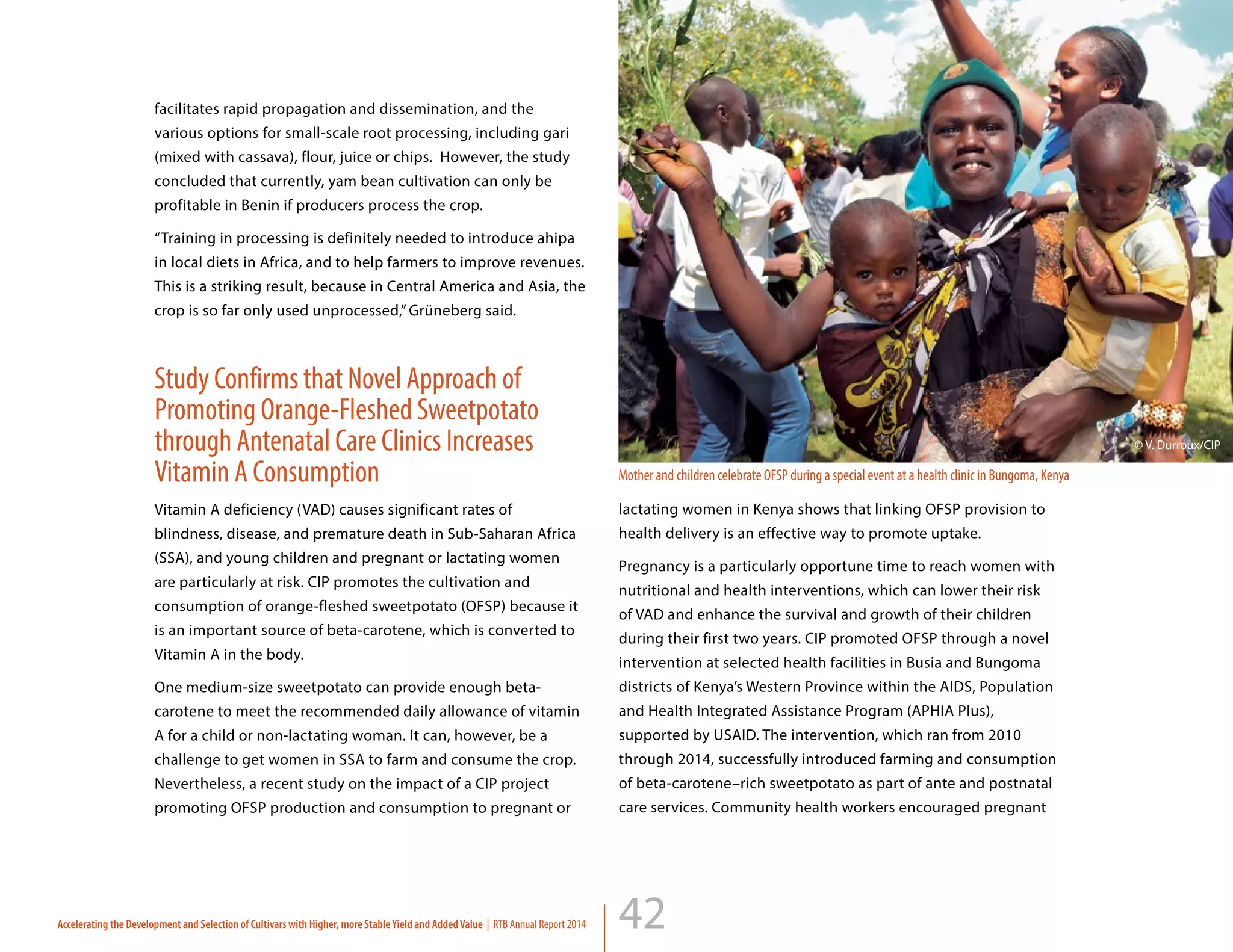







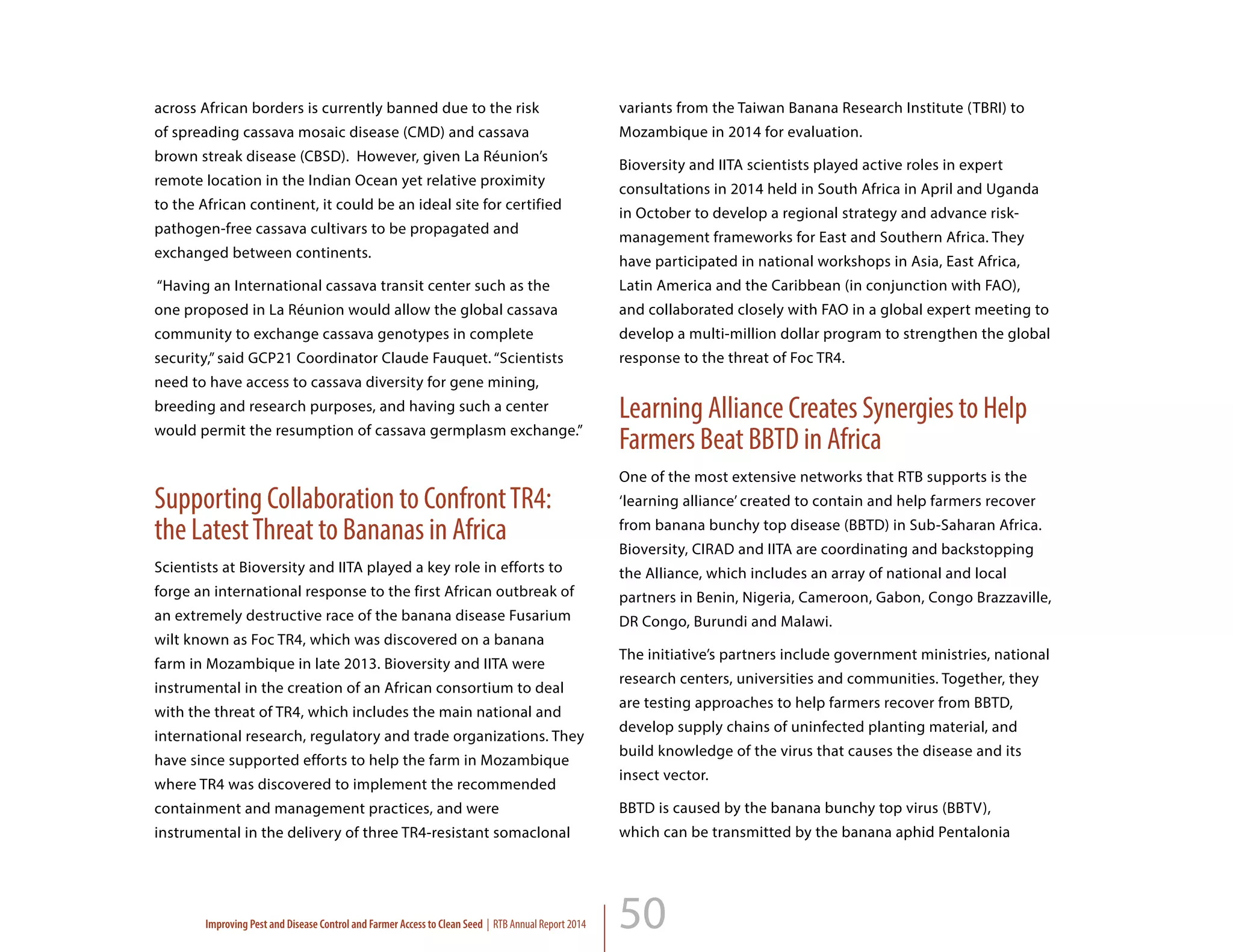

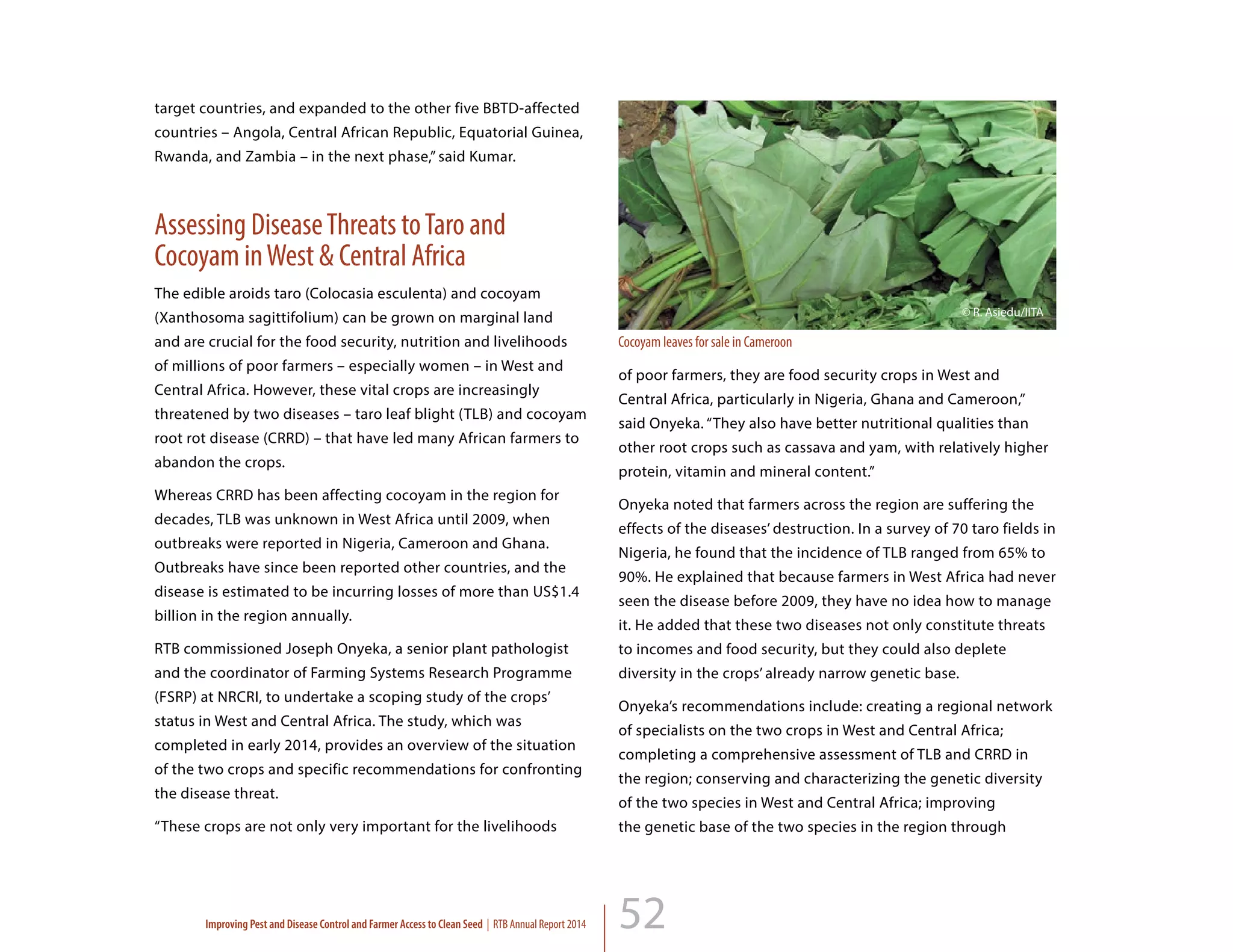
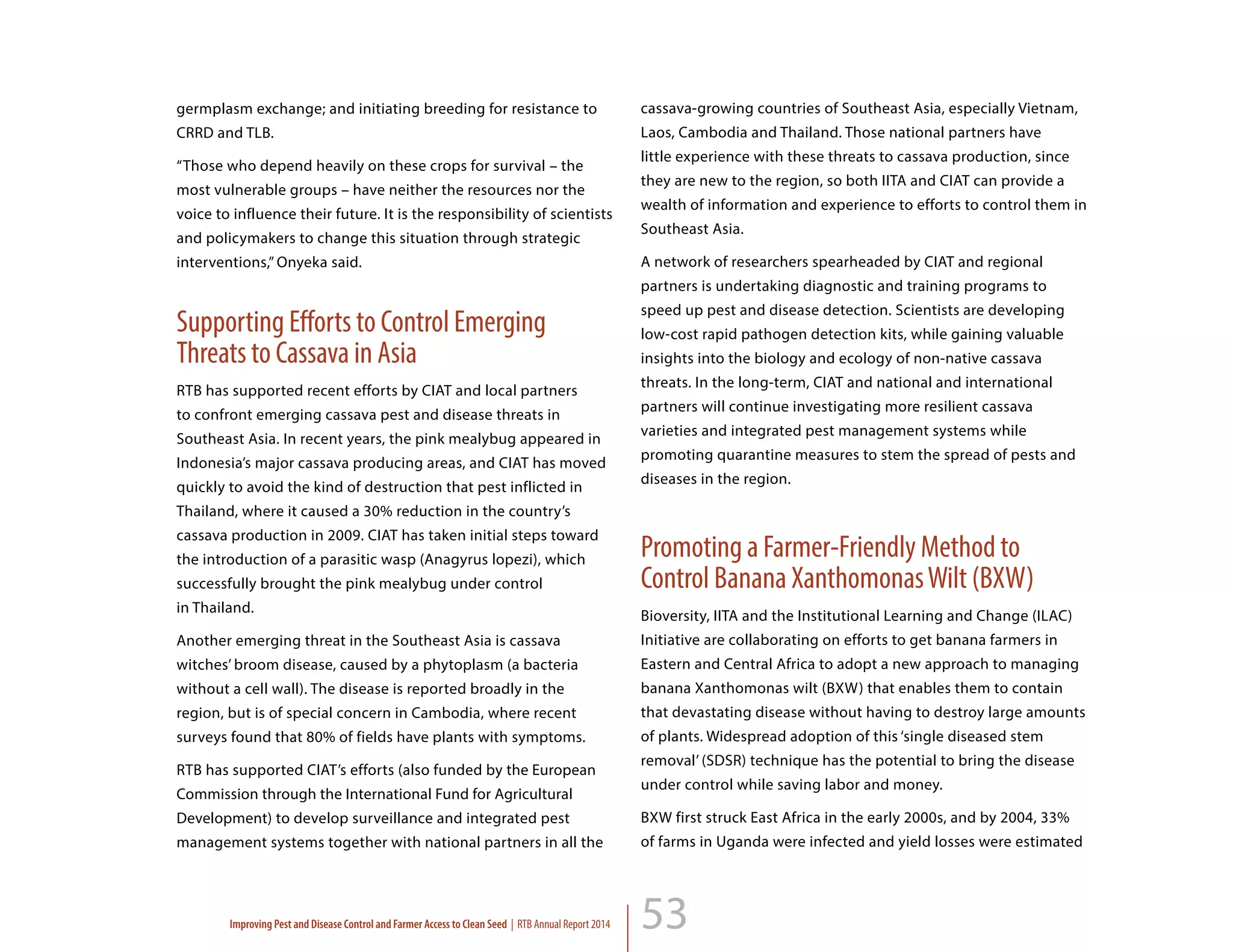

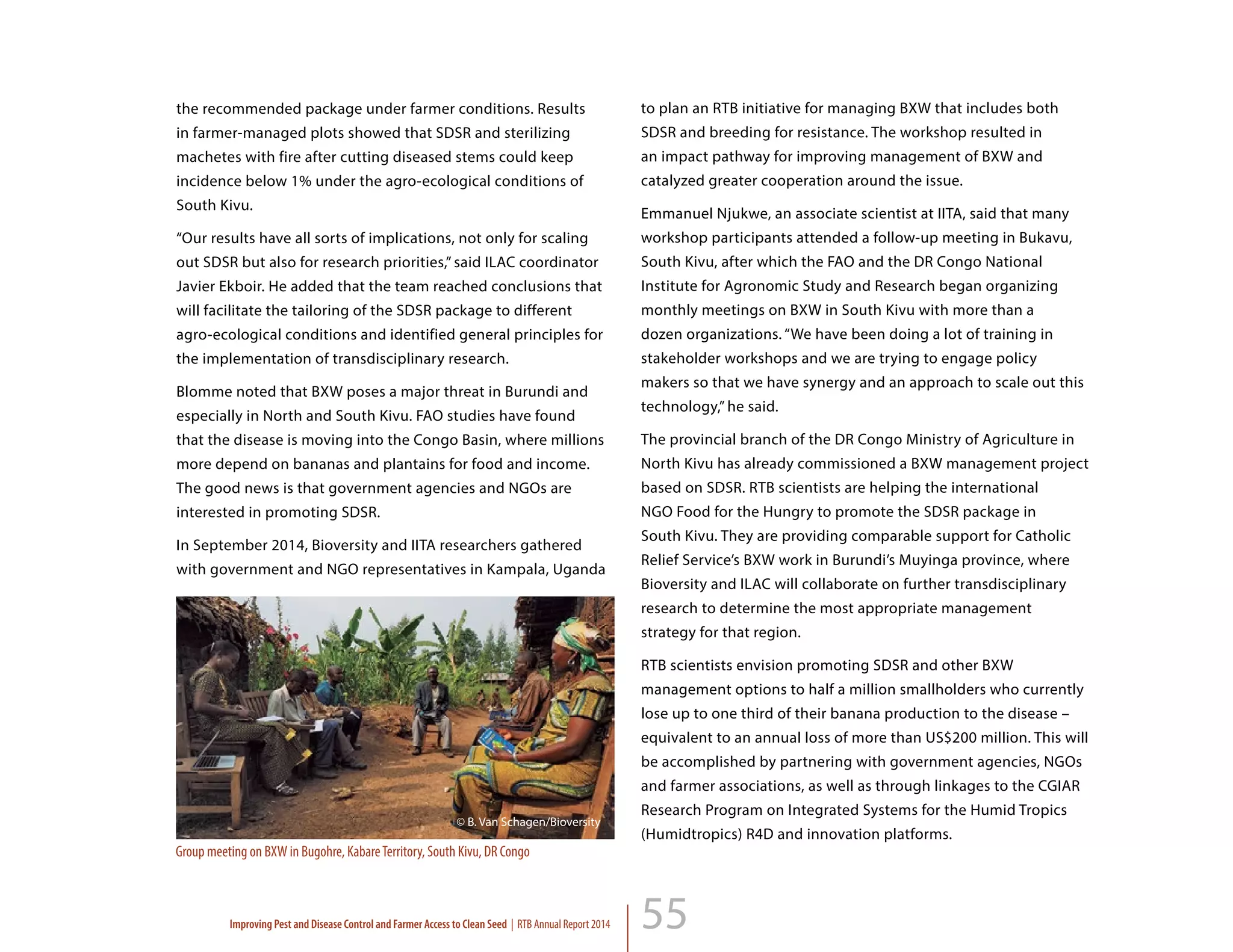








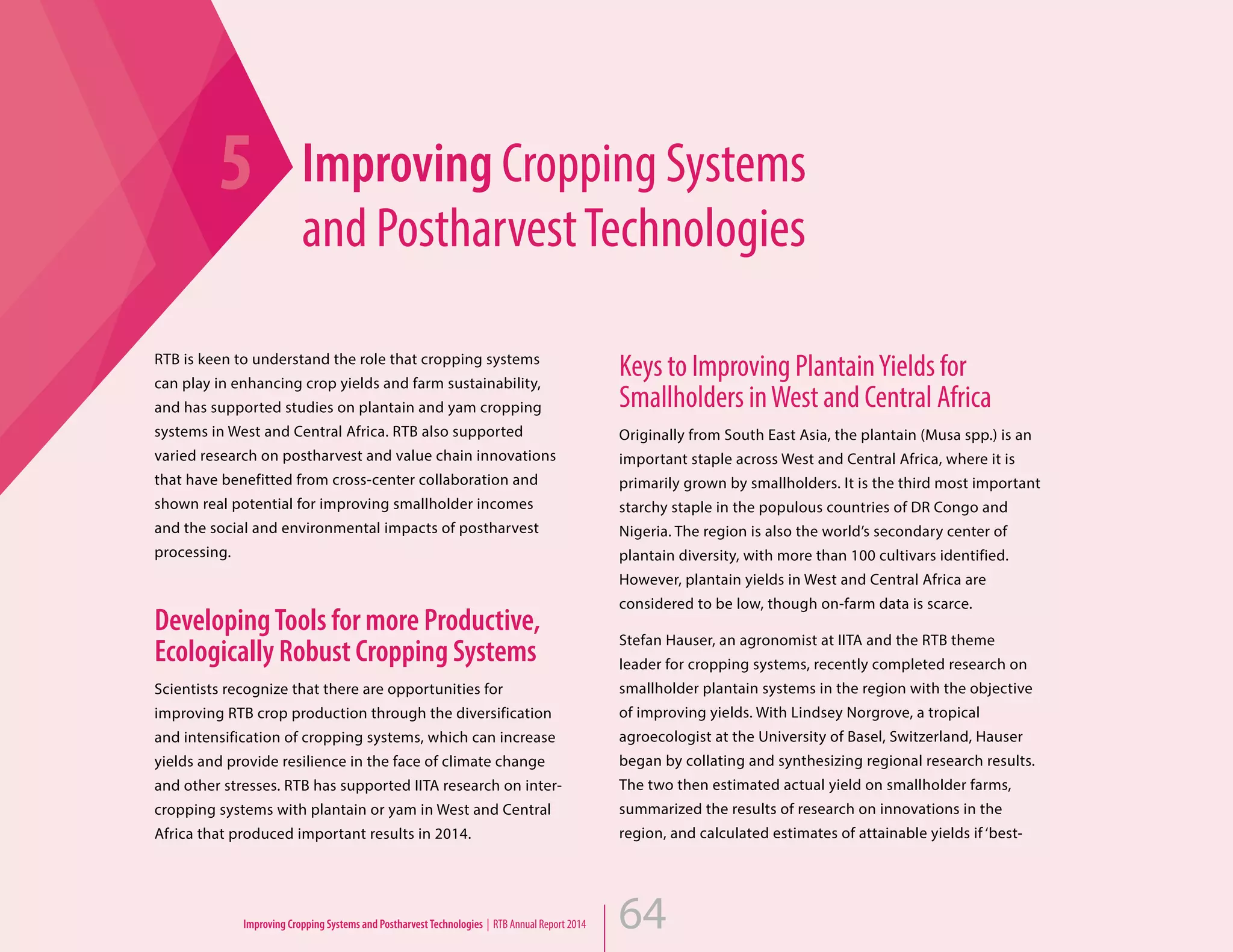
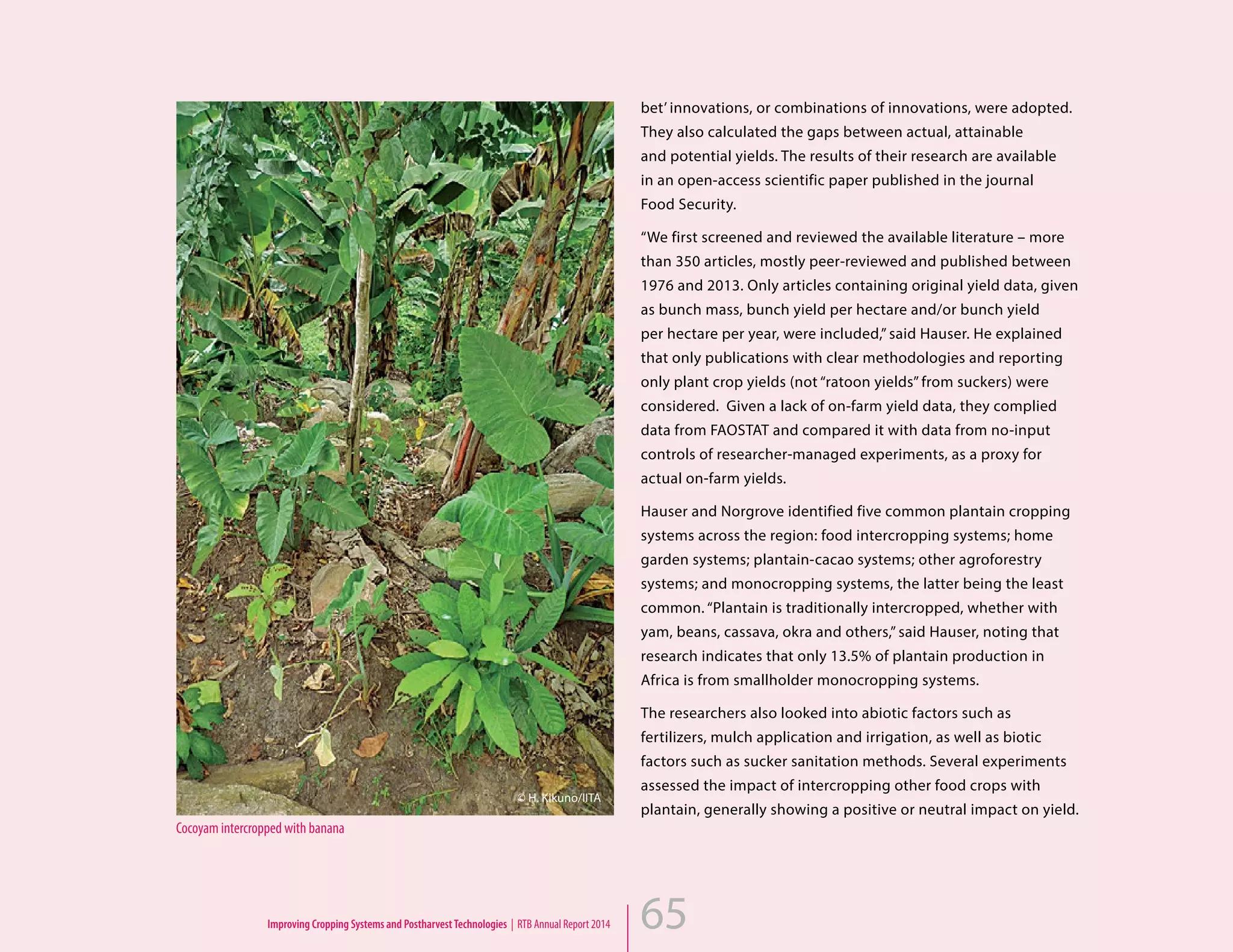


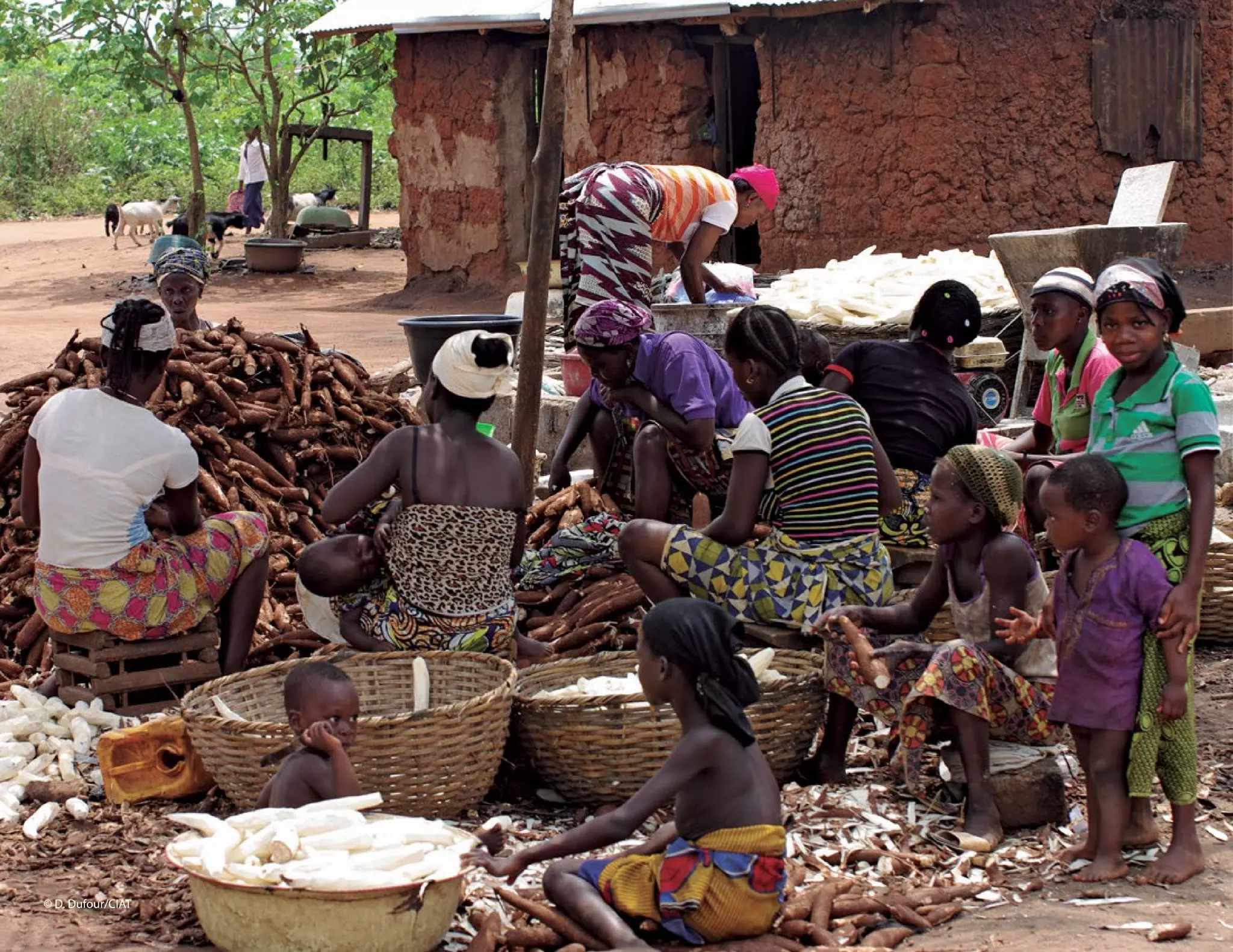

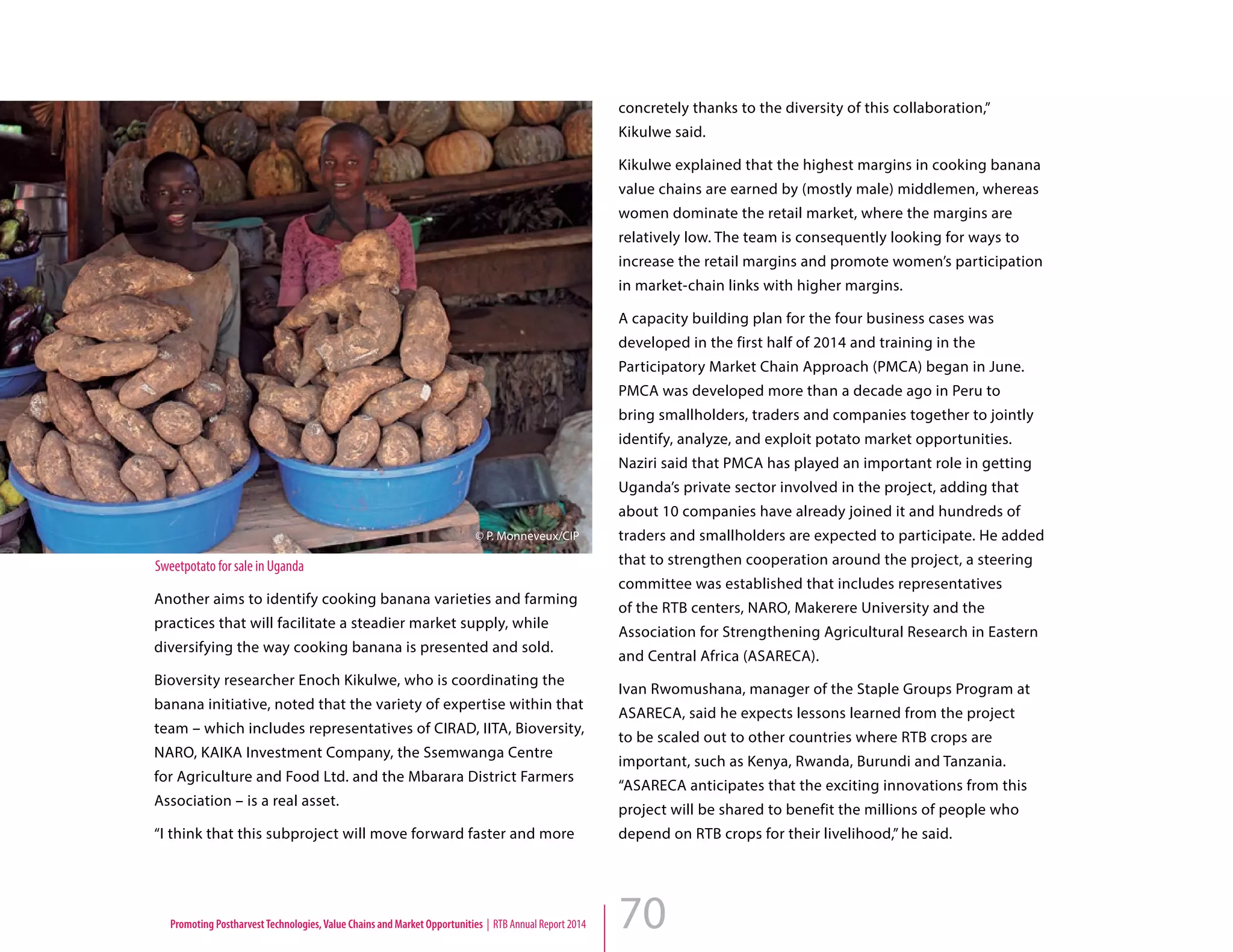
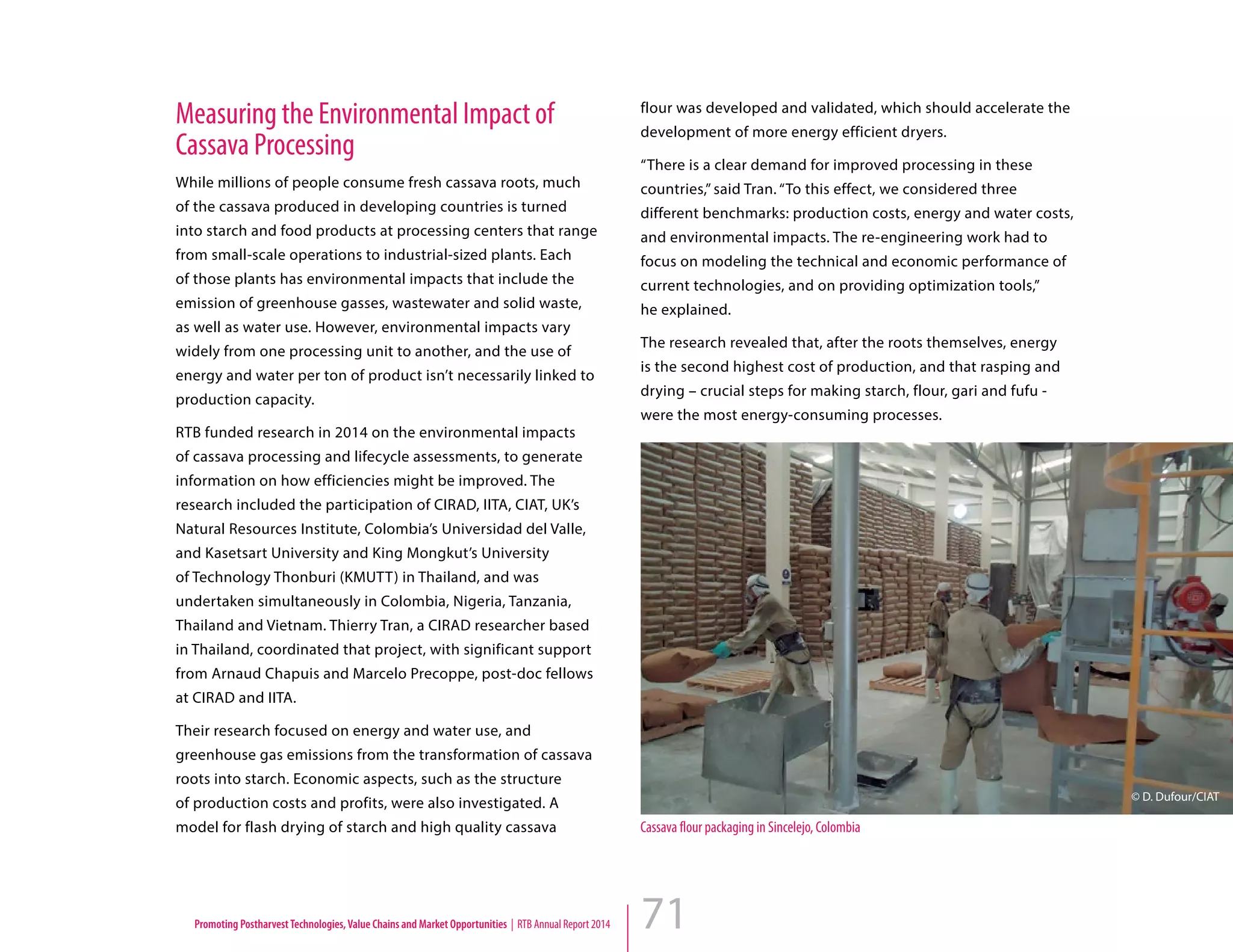

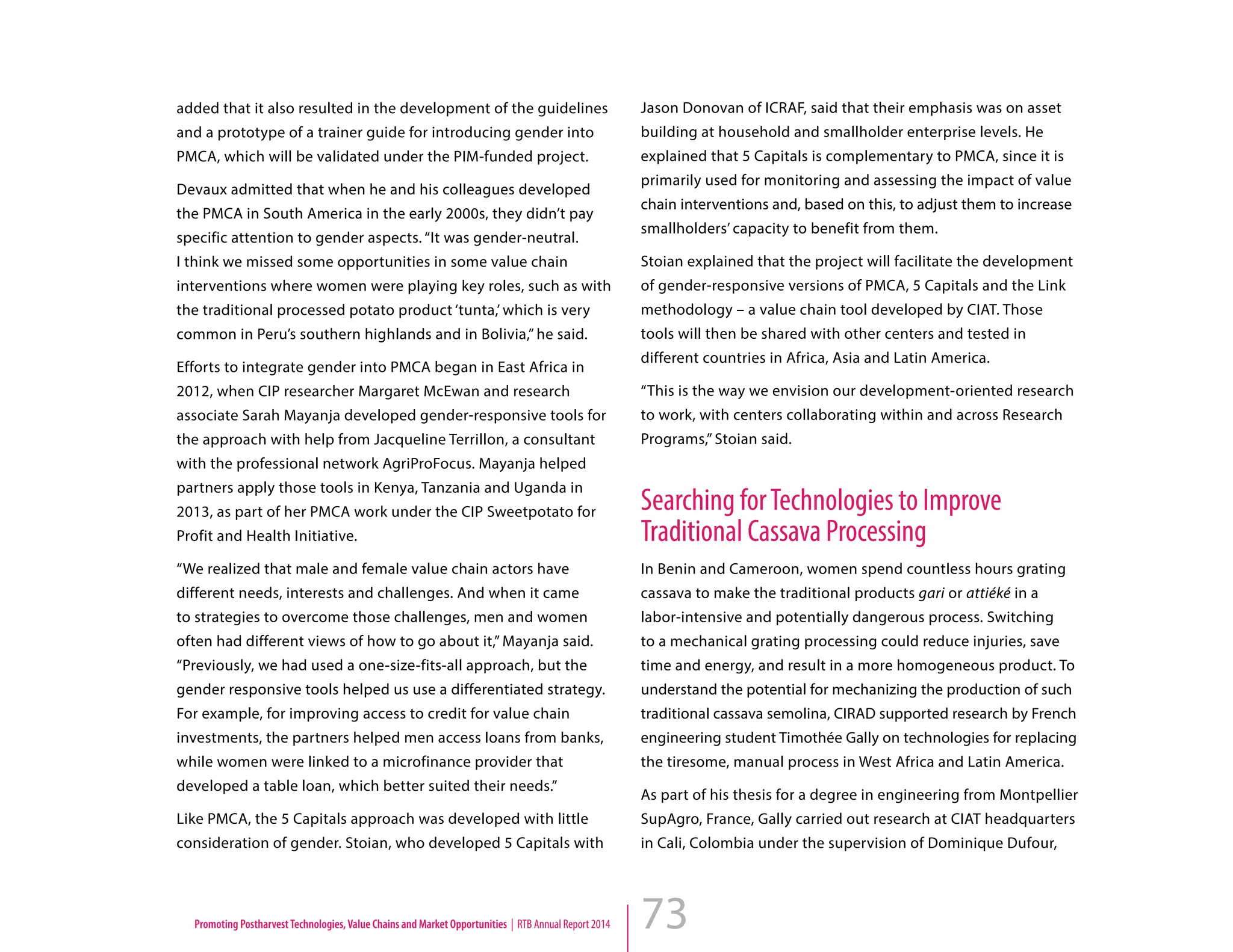




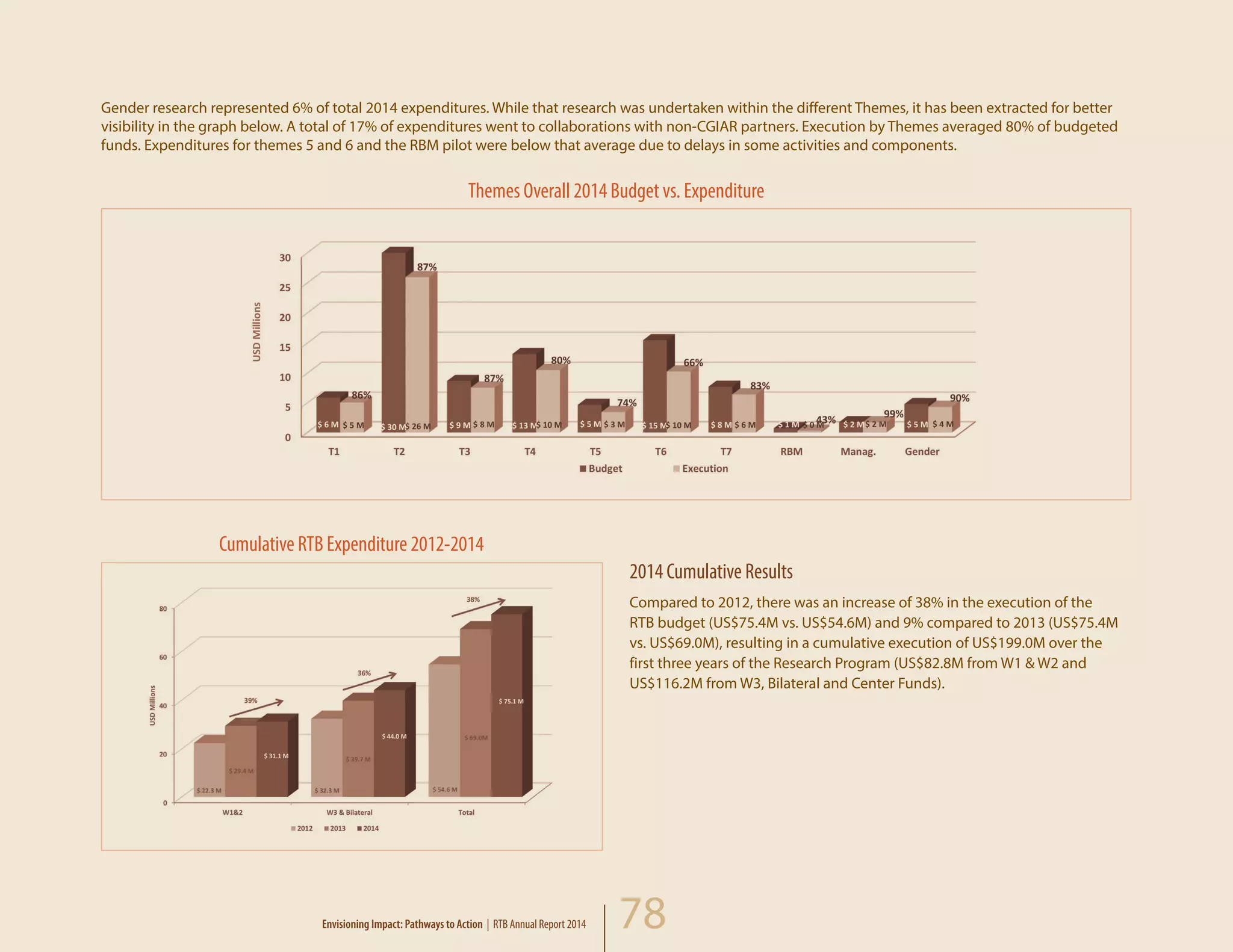



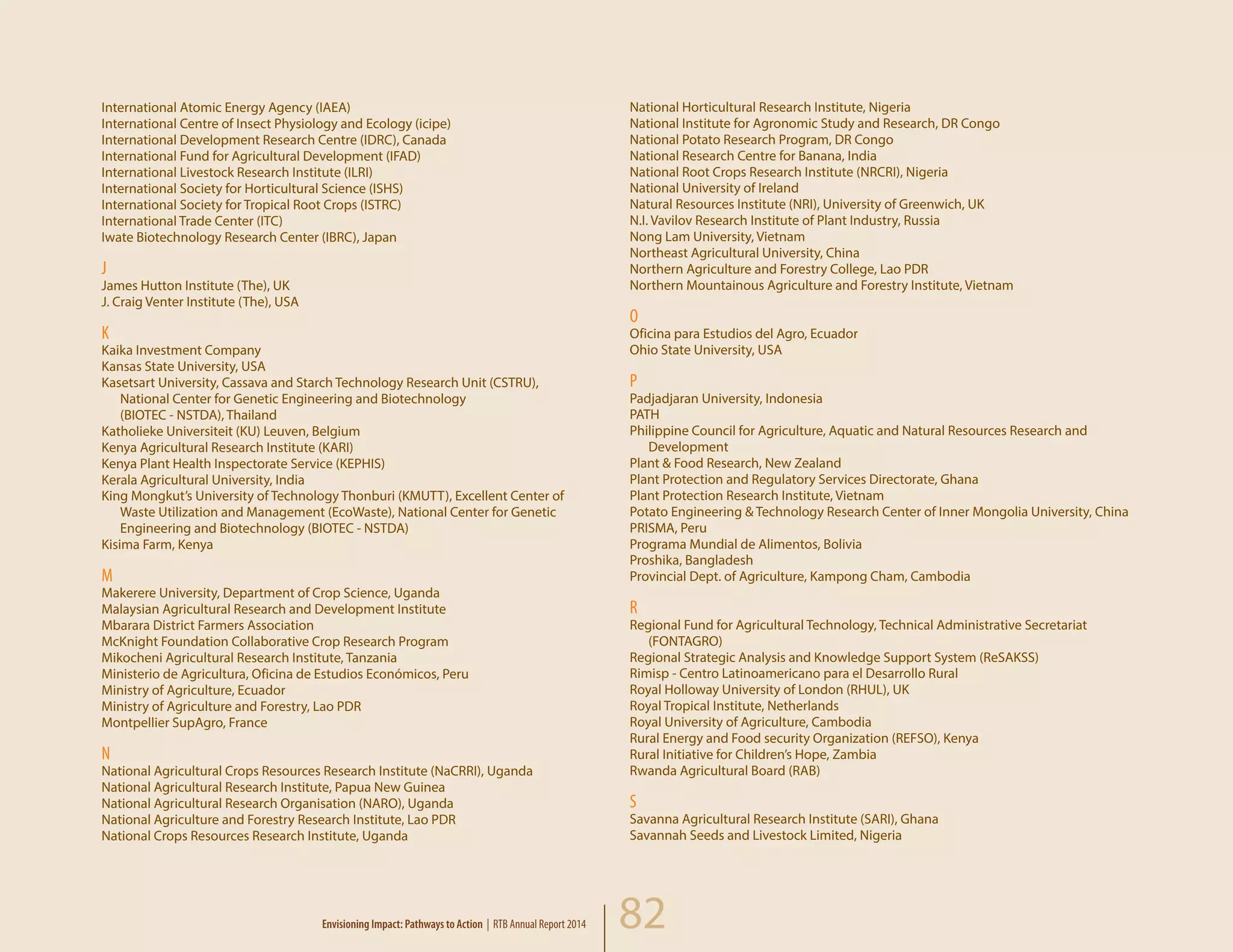



![86
Journal Articles
Girard, A.W., Grant, F., Okuku, H.S., Akelo, V., Wanjala, R., Levin, C., Cole, D.,
Low, J. (2014). Evaluating the effectiveness of a nutrition-sensitive agriculture
intervention in Western Kenya: design of the Mama SASHA cohort study of vitamin A.
The FASEB Journal (USA), 28(1): Supl. 1019.2, ISSN 0892-6638. http://www.fasebj.org/
content/28/1_Supplement/1019.2.short
Hernandez Martinez, P., Vera Velasco, N.M., Martinez Solis, M., Ghislain, M.,
Ferre, J., Escriche, B. (2014). Shared binding sites for the Bacillus thuringiensis
proteins Cry3Bb, Cry3Ca and Cry7Aa in the African sweetpotato pest Cylas
puncticollis (Brentidae).Applied and Environmental Microbiology (USA), 80(24):7545-
7550, ISSN 0099-2240. http://dx.doi.org/10.1128/AEM.02514-14
Niringiye, C.S., Ssemakula, G.N., Namakula, J., Kigozi, C.B., Alajo, A., Mpembe,
I., Mwanga, R.O.M. (2014). Evaluation of promising orange-fleshed sweetpotato
genotypes in different agroecological zones of Uganda. International Journal of
Agriculture and Crop Sciences (UK), 7(13):1312-1321, ISSN 2227-670X. http://ijagcs.
com/wp-content/uploads/2014/09/1312-1321.pdf
Okello, J.J., Sindi, K., Low, J. (2014). Consumer perceptions and demand for
biofortified sweet potato-based biscuit: The case of Akarabo golden power biscuit
in Rwanda . African Journal of Food, Agriculture, Nutrition and Development,
14(3):8941-8955, ISSN 1684-5374. http://www.ajfand.net/Volume14/No3/
Okello13495.pdf
Okonya, J.S., Kroschel, J. (2014). Gender differences in access and use of selected
productive resources among sweet potato farmers in Uganda . Agriculture and Food
Security, 3(1):10 p., ISSN 2048-7010. http://dx.doi.org/10.1186/2048-7010-3-1
Okonya, J.S., Mwanga, R.O.M., Syndikus, K., Kroschel, J. (2014). Insect pests
of sweetpotato in Uganda: farmers’perceptions of their importance and control
practices. SpringerPlus: Biomedical and Life Sciences, 3:15 p., ISSN 2193-1801. http://
dx.doi.org/10.1186/2193-1801-3-303
Rodriguez Delfin, A., Posadas, A., Quiroz, R. (2014). [Yield and nutrient uptake
in sweet potato plants grown with salt and water stress]. Rendimiento y absorción
de algunos nutrimentos en plantas de camote cultivadas con estrés hídrico y salino.
Revista Chapingo. Serie: Horticultura (México), 20(1):19-28, ISSN 1027-152X. http://
dx.doi.org/10.5154/r.rchsh.2013.01.001
Rukarwa, R.J., Mukasa, S.B., Odongo, B., Ssemakula, G., Ghislain, M. (2014).
Identification of relevant non-target organisms exposed to weevil-resistant Bt
sweetpotato in Uganda . Biotech (Germany), 4(3):217-226, ISSN 2190-572X. http://
dx.doi.org/10.1007/s13205-013-0153-1
Yams
Journal Articles
Adaramola, T. F., Sonibare M. A., Sartie, A., Lopez-Montes, A., Franco J., Albach, D.
C. (2014). Integration of ploidy level, secondary metabolite profile and morphological
traits analyses to define a breeding strategy for trifoliate yam (Dioscorea dumetorum
(Kunth) Pax). Plant Genetic Resources: Characterization and Utilization, 1–10. http://
dx.doi.org/10.1017/S1479262114000975
Nyaboga, E., Tripathi, J., Manoharan, R., Tripathi, L. (2014) Agrobacterium-
mediated genetic transformation of yam (Dioscorea rotundata): An important tool for
functional study of genes and crop improvement. Frontiers in Plant Science, 5(463):
1-14, ISSN 1664-462X. http://dx.doi.org/ 10.3389/fpls.2014.00463
Seal, S., Turaki, A., Muller, E., Kumar, P. L., Kenyon, L., Filloux, D., Galzi, S.,
Lopez-Montes, A., Iskra-Caruana, M-L. (2014). The prevalence of badnaviruses in
West African yams (Dioscorea cayenensis-rotundata) and evidence of endogenous
pararetrovirus sequences in their genomes. Virus Research, 186: 144-154, ISSN 0168-
1702. http://www.sciencedirect.com/science/article/pii/S0168170214000094
Tessema, G., Hyma, K. E., Asiedu, R., Mitchell, S. E., Gedil, M., Spillane, C. (2014).
Next-generation sequencing based genotyping, cytometry and phenotyping for
understanding diversity and evolution of guinea yams. Theoretical and Applied
Genetics, 127(8): 1783-1794, ISSN 0040-5752. http://dx.doi.org/ 10.1007/s00122-014-
2339-2
Tropical and Andean Roots andTubers
Journal Articles
Santayana M., Rossel G., Núñez, J., Sørensen M., Delêtre M., Robles R., Fernández
V., Grüneberg W.J., B. Heider. (2014). Molecular characterization of cultivated
species of the genus Pachyrhizus Rich. ex DC. by AFLP markers: Calling for more data.
Tropical Plant Biology, 7:121–132. http://dx.doi.org/10.1007/s12042-014-9143-7
Envisioning Impact: Pathways to Action | RTB Annual Report 2014](https://image.slidesharecdn.com/5b292f94-4eaa-41b2-ba89-fb7c0436ddde-151017235832-lva1-app6892/75/Annual-Report-RTB-2014-86-2048.jpg)

